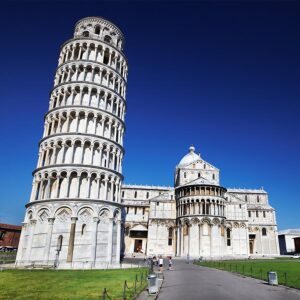Pisa
Known all over the world for the Tower in Piazza del Duomo – also known as Piazza dei Miracoli – which has been leaning heavily since its erection in 1173.
But Pisa is certainly not reducible to the Tower of the same name. Situated just a few kilometres from the mouth of the Arno, there is historical evidence to suggest that its foundation dates back to the Villanovan age. But it was in Roman times that the settlement grew and became famous, first becoming a municipality and then a colony.
A bit of history of Pisa
With the fall of Rome the city did not lose importance thanks to its fleet, both militarily and commercially, and this brought it to be, already in the late Middle Ages, a power of historical level, so much to be worth the title of Maritime Republic and to have, together with the other 3 of its peers (Genoa, Venice and Amalfi), the control of the maritime trades in the whole Mediterranean.
Continuous wars with its rival Genoa and an economic crisis at the end of the 14th century brought it under the dominion of Florence in 1400. This loss of independence, in addition to the oppression and abuse of the city of the lily, aimed at subduing rebellions, led to the depopulation of Pisa and wars with the Florentines that brought the curtain down on the golden age of Pisa for good.
What to see in Pisa
The city is, given its history, understandably full of artistic legacies from the most important masters, and the beauty of the Alphaean city is already evident from its most famous architectural monument, the Duomo di Santa Maria Assunta. Located in Piazza dei Miracoli, it was begun in 1063 and completed in 1092, and represents such a mixture of architectural styles that it can be unequivocally defined as ‘Pisan Romanesque’. A symbol of the prestige it achieved as a Maritime Republic under the leadership of Buscheto, the church was built outside the early medieval walls, in an area outside the city, precisely to testify to the strength of the Republic, which feared no attack. Over the years, the building has been constantly enlarged and restored, with works dating back up to five centuries. The Duomo boasts works by some of the most famous artists, including Cimabue, who worked on the mosaic in the apse, Giambologna, who worked on the bronze doors, and various paintings by Tempesti.
Many of the works in the Duomo were spoliated by Napoleon and are now in the French Louvre museums. Opposite the Duomo is the famous Leaning Tower, the bell tower of Santa Maria. Designed by Bonanno Pisano in Romanesque style and built between 1173 and 1372, it is 58 metres high and has a mass of almost 15,000 tonnes. Its characteristic slope is due to a subsidence of the ground below that occurred in the early stages of construction.
Opposite the Duomo is the famous Leaning Tower, the bell tower of Santa Maria. Designed by Bonanno Pisano in Romanesque style and built between 1173 and 1372, it is 58 metres high and has a mass of almost 15,000 tonnes. Its characteristic slope is due to a subsidence of the ground below that occurred in the early stages of construction.
The Church of San Francesco was also devalued by Napoleonic plundering and deprived of works by artists of the calibre of Cimabue and Giotto, but despite this, its Gothic-Renaissance structure makes it an essential stop on the Pisan itinerary, even though it is currently disused and closed to the public, it is still possible to admire its exterior.
The Pisan lungarnos
While visiting Pisa, you should also admire the wonderful lungarni, the real heart of the city, where people have been gathering since ancient times, and which in the evening are coloured by a thousand lights thanks to the beautiful cafés and pubs that dot them, and the casetorri – among which the most famous and characteristic is the Torre del Campano, a beautiful example of medieval style architecture located in via Cavalca, near the city’s University, one of the oldest in the world, since it was officially established in 1343, although a complex that corresponded to the concept of “universitas” was probably already present a couple of centuries earlier.
Villa dei Bosconi Surroundings
Florence
Fiesole
Siena
San Gimignano
Lucca
Chianti
Our Rooms
Standard Double Rooms
Superior Double Rooms
Triple Rooms
Quadruple Rooms

